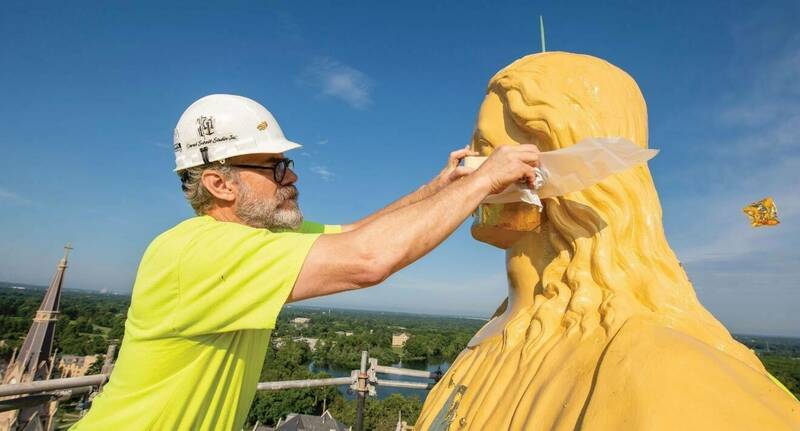 Photo by Barbara Johnston
Photo by Barbara Johnston
I was taking a lunchtime walk on campus in mid-July and paused on a bench near the Hesburgh Library reflecting pool. Nearby, a modest garden of native flowers in bloom attracted a few bumblebees and other pollen-gathering insects.
A sudden flutter of yellow caught my eye. I thought it was a butterfly, but then I noticed it was shiny. The breeze carried the small piece of glittery material to the ground.
I carefully picked it up, the edges crumbling to my touch. I realized what it was. About 1 inch by 1 inch, it was a wisp of gold leaf flown loose from the work on the Golden Dome.
It was a once-in-a-generation kind of summer on campus, like the emerging of 17-year cicadas. Right after commencement, scaffolding started going up around the Main Building in preparation for the regilding of the Golden Dome and the statue of the Virgin Mary.
This was the 12th time the landmark has undergone gilding since the Dome and the statue were placed atop the building 140 years ago. The scaffolding and the sight of the workers going about their daily tasks so high above campus became a daily attraction. Campus tour groups stopped to watch and employees sometimes walked out of their way to see how the project was progressing. The workers looked tiny next to the 17-foot-tall statue.
I’ve been around long enough to see three regildings. I climbed the metal stairs on the scaffolding during the 1988 project for a closeup look to write a newspaper article. I’ve since retired from such assignments. I watched from afar — and at ground level — during the 2005 regilding.
After the Great Fire of 1879 destroyed Notre Dame’s second Main Building, work began immediately on construction of the current Main Building. It was complete enough for students to return for classes a few months later.
But University founder Rev. Edward F. Sorin, CSC, had even bigger plans. He ordered a statue of Mary, made of cast iron sheeting, which arrived in July 1880. It was funded by the sisters, students and alumnae of neighboring Saint Mary’s College. At first, the 4,400-pound statue was displayed on the roof of the new building’s front porch, but Sorin insisted that it be placed atop a dome crowning the Main Building, just as one had appeared on its predecessor. Only this time, he wanted both to be covered in gold.
That was a tough sell to the Congregation of Holy Cross’ administrative council. The University wasn’t flush with money in the 1880s, and the campus was still recovering from the devastating fire. To some, the founder’s demand must have seemed downright foolishness.
The Dome was added in 1883 and the statue of Mary raised atop it in October of that year. In 1886, Sorin — still insisting on a gilded dome — appointed himself chair of the administrative council, moved to Saint Mary’s and refused to hold meetings until his wish was granted.
He got his way. The dome and the statue were covered in gold.
For Sorin, this was no mere whimsy or fit of pique. It was a goal he had set nearly 40 years earlier, shortly after he founded his boys’ school on the American frontier. He wrote at the time: “When this school, Our Lady’s school, grows a bit more, I shall raise her aloft so that, without asking, all men shall know why we have succeeded here. To that lovely Lady, raised high on a dome, a Golden Dome, men may look and find the answer.”
When Sorin penned those words, his small school was a fledgling thing, as potentially ephemeral as that fragment of gold leaf I found fluttering on the quad.
The priest’s quirky insistence not just on a dome but on a golden dome produced Notre Dame’s greatest landmark, recognized today around the globe. Twelve gildings later, it stands as one of Sorin’s best ideas.
Margaret Fosmoe is an associate editor of this magazine.